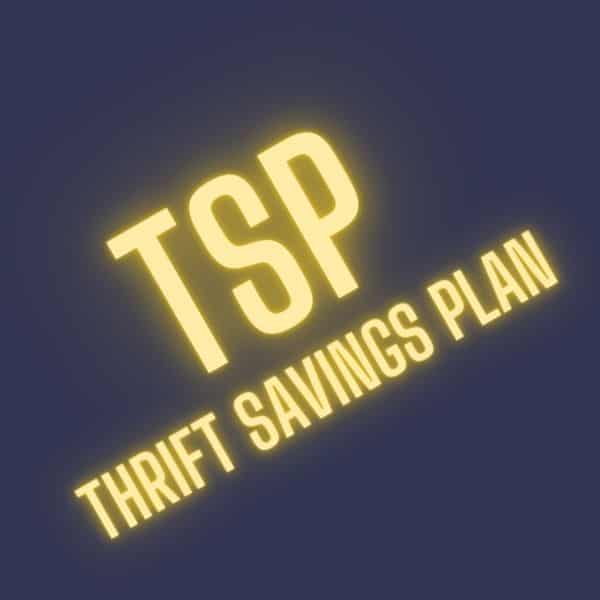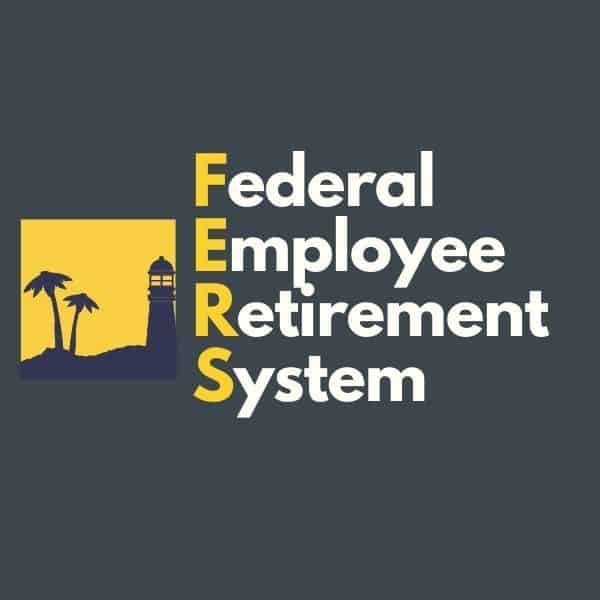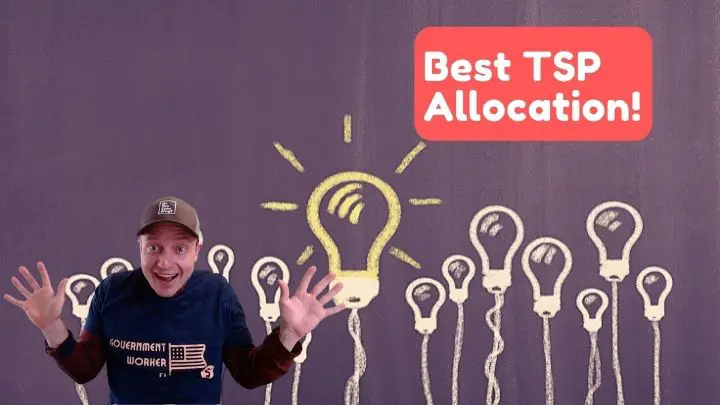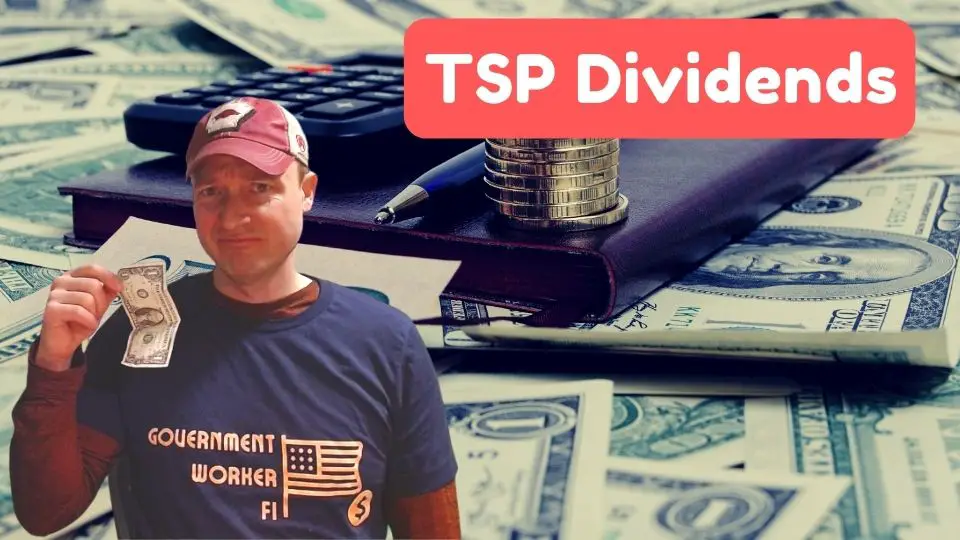If you had to retire tomorrow would you have enough money?
If you’re a federal employee, chances are you have less than $50,000 saved in your TSP. However, CNBC estimates that most Americans will need $1.7 million to retire. Despite this benchmark, less than 0.5% of TSP participants have saved a million dollars in their TSP.
If you want to supercharge your retirement savings you might consider trying to max out your TSP.
In this post I’ll walk you through what the TSP is, how it works and how much it takes to max out your TSP. I’ll also talk about my history with the TSP my own TSP contributions and give you the best reasons you should consider making the max TSP contribution.
Table of Contents
- What is the TSP?
- How does the TSP work?
- Differences between the TSP and 401(k)
- What is the max TSP contribution for 2023?
- My long path to max out my TSP
- Frequently Asked Questions
- 3 Reasons *not* to invest in the TSP
- Summary- should you max out your TSP?
Please do not confuse my personal blog for financial advice, tax advice or an official position of the U.S. Government. This post may contain affiliate links. If you make a purchase after clicking on a link, I get a small percentage of the sale at no additional cost to you.
What is the TSP?
TSP stands for “Thrift Savings Plan”. The TSP is a defined contribution plan for federal employees similar to a 401(k) in the private sector. The TSP is just one part of your federal retirement plan. Most permanent federal employees can contribute to the TSP. However, some federal employees do not have access to the TSP but instead can contribute to a 401(k). Some lucky employees can contribute to both a 401(k) and a TSP.
How does the TSP work?
The Internal Revenue Service treats the TSP like a 401(k) and gives you tax advantages for contributing to the plan. The IRS gives you a tax advantage because they want to see you save money for retirement. While the TSP is primarily a retirement account, you can also make hardship withdrawals in an emergency.
You can withdraw money from the TSP in installment payments, single payments, or even purchase a TSP annuity in retirement.
The type of the tax advantage depends on if you decide to contribute to a traditional TSP or a Roth TSP.
If you contribute to a traditional TSP you can defer paying taxes on the money you contribute. If you contribute to the Roth TSP, you put after tax dollars into the TSP but never have to pay tax on withdraws from the TSP.
Both plans give advantages over investing the money in taxable accounts. However, whether you should invest in the Roth TSP or Traditional TSP depends on your current level of income and expected future taxes.
Get Gov Worker’s top 4 tips for federal employees!Differences between the TSP and 401(k)
Not for profit
Most 401(k) providers in the private sector act as for-profit entities. In other words, they provide a service to a business (setting up a 401(k) plan for their employees) and in exchange earn money. These providers earn money based off of fees they charge plan participants.
The TSP is set up to cost federal employees as little as possible and operates as a non-profit. The TSP fees are only $0.42 per $1,000 invested (i.e. 0.042%). CNBC estimates that most Americans pay between 0.37% and 1.42% in their 401(k)s— between 9 and 33 times more than TSP participants.
Simplified fund selection
To offer such low fees, the TSP offers unique investment funds. These are not securities traded on the SEC, but rather trust funds regulated by the Comptroller of the Currency.
These funds track commonly used benchmark index funds. For example, the C Fund follows the S&P 500 index, the I Fund gives international exposure, and the F Fund invests in a broad array of bonds.
You can also invest in Lifecycle Funds for a set-it-and-forget-it solution.
The result is that you are able to build a balanced portfolio very cheaply within the TSP.
The simplified fund selection also helps investors avoid the siren song of actively managed funds with high fees (like a 5% load on investments) and dubious track-record of returns.
Government match on TSP
One of the biggest benefits of government employment is the match on your TSP contributions. The government will match your contributions to the TSP up to 5% of your gross income.
Automatic enrollment
Are you unsure if you’re contributing to the TSP?
New employees are automatically enrolled to contribute 5% of their pay to the TSP. However, if you started your government career a long time ago, you would have had to enroll yourself.
If you have any questions, you should log into the TSP website today and check. You will definitely want to contribute at least 5% of your pay to get the full employee match. (It’s free money!).
What is the max TSP contribution for 2023?
The max TSP contribution for 2023 is $22,500.
The maximum amount you can contribute is set by the IRC Sections 402(g). Technically, the IRS refers to this $22,500 limit as the “elective deferral limit”.
The 5% government match is not included in the $22,500 limit.
If you want to set up your direct deposit to achieve the maximum TSP contribution each year, you should set up an elective deferral of $866 per pay period.
Note that if you are older than age 50, you are allowed to make “catch up” contributions. You are allowed to make an additional $7,500 of catch up contributions for a total of $30,000 per year.
Total Contribution Limit
I should note that the maximum amount that can be contributed to the TSP in a year is $66,000 between the employee contribution ($22,500) and the government match.
However, given the size of government salaries and the employer match (5%) this limit should not affect federal employees.
My long path to max out my TSP
I have always been a finance nerd.
You would think that I have been contributing the max to my TSP for my whole adult life.
But that’s not the case.
When I could first contribute to the TSP at age 22, I loved reading and watching Jim Cramer and Suze Orman. (I wish JL Collins had published A Simple Path to Wealth back then).
Cramer’s advice in 2007 was that 401(k)’s stink and that you should only contribute to get the match. He recommended putting the remainder of your money in an IRA (or Roth IRA) where you could trade stocks.
Therefore, I enrolled at the 5% level and then contributed as much savings as I could to my Roth IRA. Instead of having a set-it-and-forget-it plan for wealth, I spent hours analyzing stocks and trying to find the best trades. I now feel like I would have been better served investing in one of the best Vanguard funds for long term growth.
Childcare- a big obstacle
Not only did I not max out my TSP, but we didn’t max out our IRAs either.
I was in graduate school on a GS-7 salary and had just finished graduate school and started her first job. We tried to contributed as much as we could and put 100% of every promotion we got into savings.

But not only did we have low salaries (relative to today) but we were also making babies. Daycare put a huge drag on our retirement savings.
It seemed like every year we maxed out our IRAs, we had another baby and then the next year we had an additional $10,000 in childcare costs.
My biggest regrets
My biggest regret is that I didn’t contribute a higher percentage of my pay to the TSP when I started!
I would have never have missed the extra percentage of my income (even if it meant I contributed less to my Roth IRA in the beginning).
However, maybe it just wasn’t practical for me to contribute more at the start. We were barely scraping by as a young family and I never would have been able to max out my TSP back then.
But I think the biggest regret I have is not saving more after a big promotion 5 years ago. Back then, I still had never heard about financial independence or early retirement. I just assumed I’d have to stick around until my mid 50s.
After the promotion I looked at my new paycheck and I looked at my retirement savings. And I realized that I was on track to have more money than I needed for a traditional retirement at age 57. I couldn’t imagine why I’d want to save more money that I would never touch. So instead of saving it, we took out a HELOC to have some work done on the house.
In retrospect, if I would have used that raise to max out my TSP, I would be financially independent today.
Why I now max out my TSP
Shortly after paid to have our house upgraded, I learned about financial independence.
That was an eye opening experience for several reasons.
- Instead of listening to financial advisors tell me I needed to replace 80% of my income in retirement, I learned that I just needed to amass 25 times my spending for financial security for life.
- That meant that instead of needing $3-5 million to retire at age 57 (as a financial advisor told me), I could probably retire with $1.5-$2 million in my 40s.
- Finally, some of the “OG” FIRE bloggers such as Go Curry Cracker and the Mad Fientist help me understand why I should contribute to my traditional TSP account now and withdraw the money tax-free through Roth conversion ladders.
I now am happily maxing out my TSP!
Frequently Asked Questions
How to max TSP contributions?
To meet the maximum contribution of $22,500 per year, you should contribute $866 per pay period. Most Agencies allow you to set up your TSP contribution as a dollar amount or a percentage. Because it’s hard to calculate the exact percentage of your pay that equals $866, you are better off choosing to set up a dollar amount.
Does max TSP contribution include matching?
No. The government match does not count in the $22,500 limit. However, it does count towards the total contribution limit of $66,000. (Again, this should not affect federal employees on the GS pay scale getting a 5% match).
Can you max out TSP and Roth IRA
Yes. You can contribute to both a TSP and an IRA. Both TSPs and IRAs have Roth and Traditional varieties. So you can have a
- Roth TSP and a Roth IRA,
- Traditional TSP and a Roth IRA,
- Roth TSP and a Traditional IRA
- Traditional TSP and Traditional IRA
Note that there are income limits that apply to IRA contributions. Please see the IRS’s FAQs on IRAs. (That was a lot of three letter acronyms all together).
What is the max TSP matching?
The government will match up to 5% of your salary. The GS pay tables is capped at $172,500. Therefore the maximum amount of TSP matching is $8,625 per year.
3 Reasons *not* to invest in the TSP
If you’re still not sure whether you should work towards maxing out your TSP, here are 3 reasons you might not want to invest in the TSP.
1. You’re smarter than Warren Buffet
Are you an above average person? A distant descendant of Nostradamus perhaps? Jim Cramer’s nephew? If you’re confident in your ability to consistently buy and sell securities that will beat the market over your 30 year government career, then the TSP is going to seem too constraining.
Yes, you don’t want to be one of those mindless drones who just set his weekly contribution and earned an average annual return of 13% over the past decade. Instead, you want spend hours a week researching different investments and churn your portfolio.
If you can beat your TSP, you’re doing better than 91% of actively managed mutual funds, and they have teams of people helping the fund manager. With a track record like that, you might as well quit your federal job and start your own hedge fund!
2.You love giving your money to big finance
I get it. bankers and brokers have a tough life. They have to wear suits and drive expensive sports cars. And private school tuition doesn’t grown on trees. If you think it’s our civic duty to provide financial compensation to these titans of Wall Street than the TSP isn’t for you.
The TSP has the lowest fees of any employer sponsored retirement plan. Furthermore, it’s set up as not-for-profit. Instead, all those would-be profits get funneled back to participants (i.e. you). How is a broker supposed to buy a yacht when he works for a retirement plan that returns its profits to the investors‽‽‽ If you’re concerned about where your broker’s next meal is coming from, move your money out of the TSP ASAP!
3. You like paying taxes
You know that old saying, “the only guarantees are death and taxes”? Well the TSP allows you to cheat one of those two. (And no it’s not death). In fact, the TSP gives you two different options on how to handle your taxes, both of which are great. If you’re in a low tax bracket today, you can invest in the Roth TSP and have your money grow tax free forever. Otherwise, in your traditional TSP you can defer paying taxes until you’re retired, and if you do it just right, might not have to pay any tax.
But maybe you like paying taxes. That’s cool. Feel free to fund a taxable investment account instead. That way you can
- Pay tax on the money before you invest it
- And then pay tax on any dividends your investments generate
- And finally pay tax on any capital gains you get when your investments grow
I mean, paying taxes 3 times sounds way better than never… right?
Summary- should you max out your TSP?
I think there are lots of great reasons to max out your TSP. Do you disagree? Share this post on social media and tag me with your reasons why.
Get Gov Worker’s top 4 tips for federal employees!






